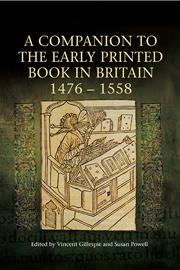Book contents
- Frontmatter
- Contents
- List of Illustrations
- List of Contributors
- Preface
- Acknowledgements
- Abbreviations
- Chronology of the Period
- Introduction
- I THE PRINTED BOOK TRADE
- II THE PRINTED BOOK AS ARTEFACT
- III PATRONS, PURCHASERS AND PRODUCTS
- IV THE CULTURAL CAPITAL OF PRINT
- Index of Manuscripts
- Index of Printed Books
- General Index
Introduction
Published online by Cambridge University Press: 05 April 2014
- Frontmatter
- Contents
- List of Illustrations
- List of Contributors
- Preface
- Acknowledgements
- Abbreviations
- Chronology of the Period
- Introduction
- I THE PRINTED BOOK TRADE
- II THE PRINTED BOOK AS ARTEFACT
- III PATRONS, PURCHASERS AND PRODUCTS
- IV THE CULTURAL CAPITAL OF PRINT
- Index of Manuscripts
- Index of Printed Books
- General Index
Summary
For as the first decay and ruine of the Churche, before began of rude ignoraunce, and lacke of knowledge in teachers: so to restore the Church agayne by doctrine and learning, it pleased God to open to man, the arte of Printyng, the tyme whereof was shortely after the burnyng of Hus and Hierome. Printyng beyng opened, incontinent ministred to the Church, the instrumentes and tooles of learnyng and knowledge, whiche were good bookes and authors, whiche before lay hyd and vnknowen. The science of Printyng beyng found, immediatly folowed the grace of God, whiche styrred vp good wittes, aptely to conceaue the light of knowledge and of iudgemēt: by which light, darkenes began to be espyed, and ignoraunce to be detected, truth from errour, religion from superstition to bee discerned.
Like all totalising narratives, John Foxe's polemical narrative of the invention of printing as a providential preliminary to the wholesale reformation of the Church can only work by omitting much that is inconvenient in the story. But his ideologically biased analysis, mounted from the Protestant haven of Elizabethan England, formed only a few years after the change of regime that marks the terminal date for this volume, has the merit of reminding us that there is much more to the history of printing in England than Caxton and his chivalric and gentry romances that have occupied so much space in literary and general histories of the period.
- Type
- Chapter
- Information
- Publisher: Boydell & BrewerPrint publication year: 2014

